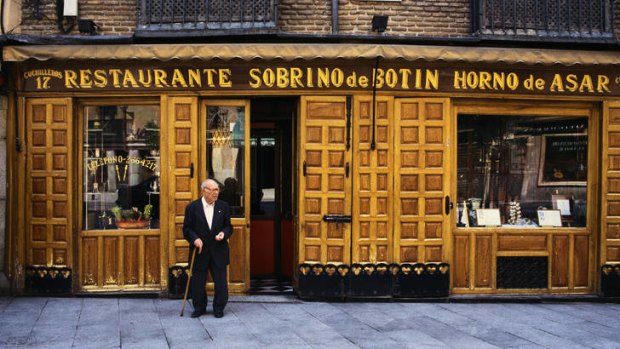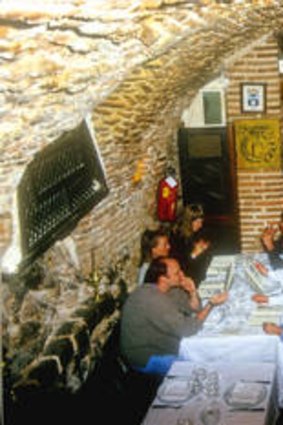
If these walls could talk...Restaurante Botin has survived wars and generations of owners.Credit: Corbis
Restaurante Botin's suckling pig has fed a procession of famous names for three centuries. Lance Richardson discovers why.
As with the dishes they serve, most restaurants have a limited shelf life. ElBulli closed its doors last year, though the Catalonian home of molecular gastronomy had long ceased serving for more than six months of every year. In New York, Elaine's lasted 48 years, during which time it was transformed from a modest avenue bar into one of America's most prized establishments. Bilson's, in Sydney, faded last year as well: the tax department sent a bill that made its $280 degustation menu look like a steal.
Restaurante Botin is on Madrid's Calle de los Cuchilleros, which means "street of the knife-grinders". Walk in and sit at a table and you'll be handed a menu with a title page of bold type arranged above a sketch of the Three Musketeers being served a steaming platter of suckling pig (the Musketeers may be French, but the suckling pig bridges all cultural rivalries). The type makes it clear that this place is a singular institution: "Founded in 1725. Earliest restaurant in the world," it reads in capital letters. Then, in either a bid for modesty or a canny legal caveat: "(According to the Guinness Book of Records)."

Botin's cavernous interior.Credit: Alamy
Botin has been serving customers for 287 years. People were eating Iberian ham here before Captain Cook took his vessel through the southern hemisphere. More pigs have passed through the oven than there are on the entire island of Kauai - about 50 a day, in fact.
When the Frenchman Jean Botin built his posada, or inn, in Madrid, he could hardly have imagined a dishwasher would turn out to be Goya, or that centuries later Ava Gardner would dance flamenco on a tabletop, and Soviets and Americans would share jokes from neighbouring tables during the Cold War.
During the Spanish Civil War, militia barged in, pulled out their guns and tried to drag away Emilio Gonzalez, the proprietor at the time. "What good is this man to you dead when alive he can feed you?" demanded Amparo Martin, his wife. Thus Botin spent time as a private dining room for members of the military. After the civil war, Gonzalez's son and grandsons stepped up and expanded the premises, and it evolved to become the celebrated icon it is today.
There is no shortage of fascinating tales here. Although a collection of royal signatures are framed on the wall - the king, until recently, signed his name "Yo El Rey", meaning "I The King" - modesty rules the exhibition of history.
The zeal of other establishments, which are plastered with neon signs, is largely absent. Partly this is practical: why advertise when the likes of the author Graham Greene do it for you? "I suggest that before buying purple socks, we treat ourselves to a tasty lunch at Botin," declares one character in his novel Monsignor Quixote.
Nevertheless, tourism has come to Botin in a big way since the 1960s, and getting a table can be a challenge. A good solution comes in the form of Joanna Wivell, an English expatriate with a passion for tapas and dance. Several years ago Wivell met Botin's current owners, Antonio and Carlos Gonzalez, to find out the restaurant's story. It became apparent its rich history was begging to be shared. Her idea was the Botin Experience, a tour of the restaurant before it opens for lunch or dinner, followed by a prix fixe menu of Botin classics and a gift of Talavera ceramics.
Wivell is the sort of guide you feel compelled to invite to dinner after a tour, which makes this a convenient set-up. She begins outside, charismatic and knowledgeable, but dissects each level of the restaurant in turn, from the Felipe IV dining room to the cellar tunnels once used by royalty as a sort of antiquated subway. We linger in the kitchen, where a chef stands surrounded by the tiny bodies of suckling pigs. Brought from a small town in Segovia, each is just 20 days old, glassy and pink.
Later, a wall painting bought from the reserve collection of the Prado Museum offers an opportunity to detail the evolution of Madrid, from backwater to regal Spanish capital. Every item - a diorama of the dining room, a note from Nancy Reagan, a sketch of Mickey Mouse holding a suckling pig - has a past, and Wivell weaves tangents into an exhilarating whole.
"This place is treasured by the owners," Wivell says. "It's been their whole life. The room upstairs [now a dining room] is where they actually grew up, [it's] their family dwelling. Botin has evolved over time." Evolved, perhaps, but stayed true to the things that work. Ernest Hemingway treasured this place, so much so that his regular appearances gave rise to a Hemingway table, where the writer once sat with his back to the wall. "He was a little paranoid," the waiter tells me, sliding a dish of anchovies with red peppers next to my plate.
Looking around, it is difficult to tell what would have altered since Hemingway wrote the final scene of The Sun Also Rises in 1925; the dining room seems as timeless as his novel. "We lunched upstairs at Botin's," says the narrator, Jake Barnes. "It is one of the best restaurants in the world. We had roast young suckling pig and drank rioja alta. Brett did not eat much. She never ate much. I ate a very big meal and drank three bottles of rioja alta."
I drink one bottle of rioja alta, and the roast young suckling pig is indeed very big, though its crispy skin, breaking like the crust on a pie, conceals pork so sweetly succulent it's impossible not to overindulge. More, you find yourself saying. More of everything - more Andalusian cold soup and white asparagus and delicious stories. And that's just the Spanish way, really.
Lance Richardson travelled courtesy of Rail Europe and the Spain Tourism Board.
Getting there
Singapore Airlines has a fare from Sydney and Melbourne to Madrid via Singapore from $1895, low-season return. See singaporeair.com.
Rail Europe travel passes cover Spain and Europe in a single ticket. See raileurope.com.au.
Staying there
The 1910-built Hotel Ritz Madrid, opposite the Prado Museum, has rooms from €325 ($413) a night. See ritzmadrid.com.
Eating there
The Botin Experience is available daily at 12.30pm or 7pm. It costs €55 a person. See insidersmadrid.com.
Sign up for the Traveller Deals newsletter
Get exclusive travel deals delivered straight to your inbox. Sign up now.